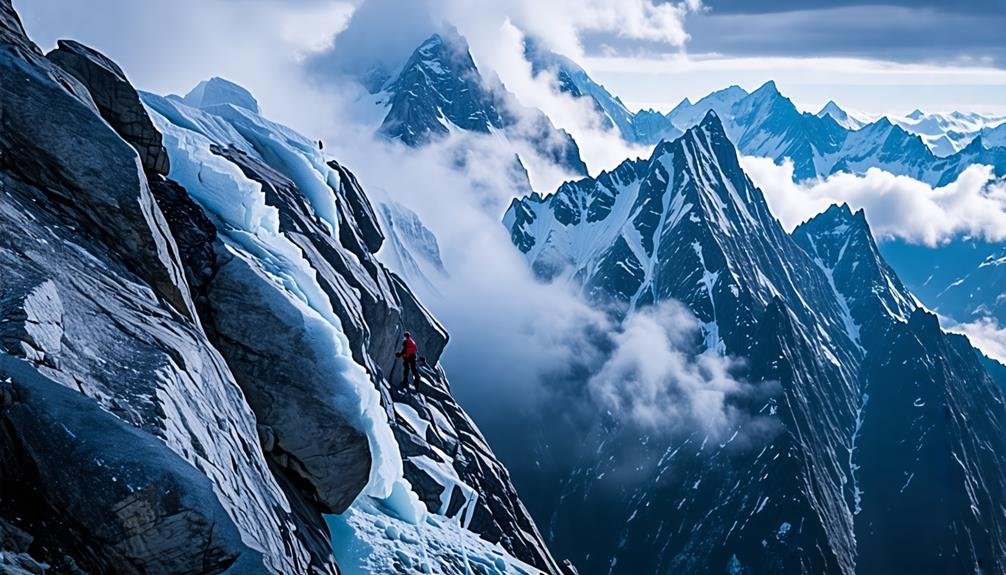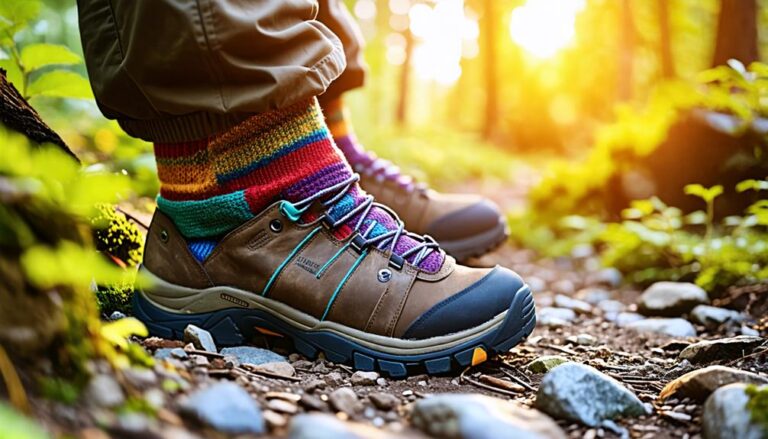Climbing the world's most perilous mountains, such as Mount Everest, K2, and Annapurna I, presents a thrilling challenge filled with incredible beauty and serious risks. For instance, Everest's Khumbu Icefall and extreme weather can pose life-threatening dangers. K2 is known for its steep ascents and avalanche threats, requiring expert climbing skills. Annapurna I has a high fatality rate due to avalanches and challenging weather. Each mountain demands respect, preparation, and understanding of its unique risks. While these climbs can be intimidating, with proper training and awareness, adventurers can experience unforgettable triumphs. There's much more to discover about these formidable peaks.
Mount Everest's Perils
Mount Everest poses numerous hazardous challenges for climbers, including the perilous Khumbu Icefall, extreme altitude effects, and unpredictable severe weather. The Khumbu Icefall is notorious for its massive ice blocks, which can shift unexpectedly and create dangerous crevasses. Climbers must navigate this icefall with extreme caution, as its instability presents significant risks.
The extreme altitude on Everest can trigger serious health complications, such as altitude sickness, affecting even seasoned mountaineers. Inexperienced climbers often underestimate these threats, resulting in dire outcomes. Proper acclimatization and attentiveness to bodily signals are crucial, as the thin air can impair both judgment and physical performance.
Furthermore, the severe weather conditions on Everest can change abruptly, with fierce storms striking without warning. This unpredictability adds a critical layer of danger, as climbers may encounter life-threatening situations. Comprehending these challenges is essential for anyone aspiring to summit Everest. While the desire to reach the highest peak is compelling, thorough preparation and respect for the mountain's hazards are vital for a safer climbing experience.
K2: The Savage Mountain
K2, known as 'The Savage Mountain,' poses significant challenges for climbers in high-altitude mountaineering. At 28,251 feet, K2 is infamous for its extreme hiking demands and perilous conditions. Climbers encounter sustained steep ascents, often averaging 45 degrees, requiring both skill and endurance. The mountain's routes necessitate technical rock and ice climbing, distinguishing K2 from other perilous peaks such as Mount Everest.
Primary challenges include:
- Unpredictable weather that shifts rapidly, heightening risks.
- Limited route options, complicating both ascent and descent.
- Avalanche threats, especially in the upper elevations.
- Technical climbing expertise essential for safety and success.
The allure of summiting K2 is compelling, yet it demands thorough preparation and respect for the mountain's formidable power. For adventure seekers, acknowledging these risks is crucial for a secure expedition. Climbing K2 transcends simply reaching the summit; it involves facing the mountain's challenges with respect and determination.
Annapurna I's Deadly Slopes
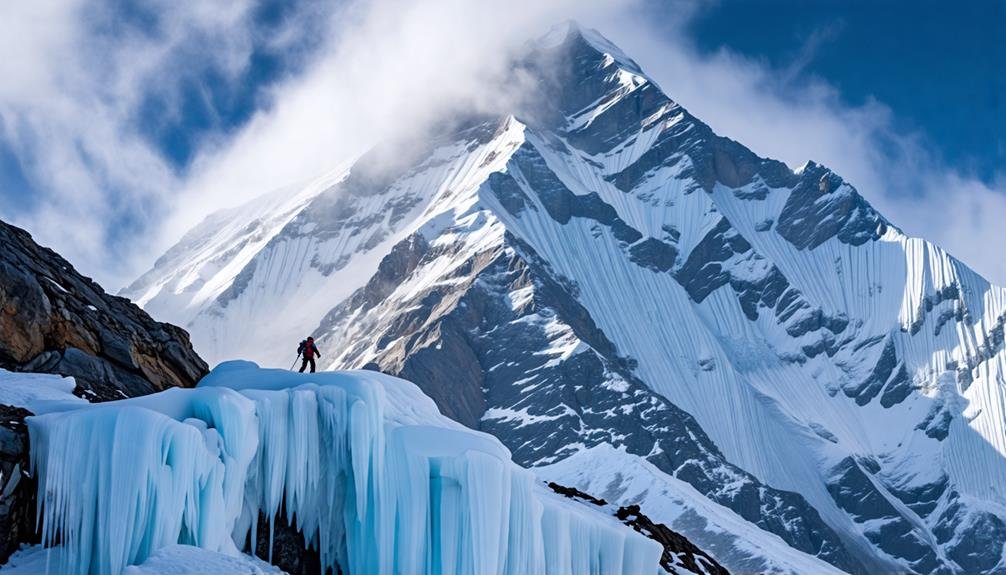
Annapurna I is infamous for its high fatality rate, having claimed the lives of 72 climbers, which highlights the dangers associated with its ascent. One significant threat is the avalanche risk, particularly from December to February, when conditions are most treacherous. Furthermore, the mountain's remote location complicates rescue efforts, making timely assistance difficult for those who encounter life-threatening situations on its steep slopes.
High Fatality Rate
The treacherous slopes of Annapurna I are infamous for their high fatality rate, resulting in the loss of 72 climbers, which positions it among the most hazardous peaks globally. This mountain is notorious not only for its technical difficulties but also for the erratic conditions that adventurers encounter. The steep ascents combined with severe weather cultivate an environment that challenges the capabilities of even the most skilled mountaineers.
Several elements contribute to this concerning statistic:
- Extreme elevation: The altitude heightens the risk of altitude sickness.
- Technical challenges: Climbers face intricate ridges and vertical cliffs.
- Weather volatility: Sudden changes can arise, allowing minimal preparation time.
- Limited rescue options: The isolated location complicates evacuation efforts.
While scaling Annapurna I offers an exhilarating experience, it is crucial for climbers to be thoroughly prepared and cognizant of the inherent risks. Knowledge and training can equip adventurers to tackle this challenge with a blend of freedom and accountability.
Avalanche Risks
Avalanche hazards on Annapurna I present a significant risk to mountaineers, particularly during the winter season when weather conditions are at their most unpredictable. The mountain's steep inclines and volatile climate create a perilous atmosphere, especially between December and February. During this timeframe, substantial snowfall can accumulate, resulting in dangerous avalanches that can descend the slopes without warning.
Climbers should identify specific zones prone to avalanches. These locations frequently include steep, exposed ridges and cliff bases where snow accumulation is more likely. Even seasoned climbers may encounter risky situations due to fluctuating weather and unstable snow conditions.
To reduce these risks, climbers must engage in comprehensive research and formulate their ascent plan with safety as a priority. Familiarity with Annapurna I's terrain and monitoring weather updates can significantly enhance the likelihood of a secure climb. Additionally, employing high-quality gear, such as Black Diamond avalanche transceivers, can bolster safety measures while traversing Annapurna I's treacherous slopes. By acknowledging the mountain's formidable force and maintaining vigilance, climbers can embrace the excitement of the challenge while prioritizing their well-being.
Rescue Challenges
Rescue missions on Annapurna I face severe challenges due to the mountain's remote position and difficult landscape, which significantly delay help for climbers in peril. The steep inclines and erratic weather conditions render these rescue efforts extremely hazardous. The inherent dangers of the mountain create a situation where every second is crucial.
Factors that complicate these rescue endeavors include:
- Elevated altitude: Diminishes the effectiveness of rescuers and raises the risk of altitude sickness.
- Severe weather: Unexpected storms can generate perilous circumstances and reduce visibility.
- Avalanche risk: Constantly shifting snow can induce avalanches, threatening both climbers and rescuers.
- Restricted access: The mountain's seclusion complicates rapid response to those in distress.
Despite these obstacles, innovations in climbing gear and communication technology have enhanced the likelihood of successful rescues. Climbers should be well-prepared and cognizant of risks, but they can take solace in the fact that committed experts stand ready to provide assistance when necessary.
Nanga Parbat's Harsh Conditions
Nanga Parbat, often referred to as the 'Killer Mountain,' presents climbers with extreme weather challenges that include fierce winds and heavy snowfall. The technical climbing hazards, such as steep slopes and rockfall risks, require both skill and caution to navigate safely. Furthermore, the mountain's remote location complicates rescue efforts, making it vital for climbers to be well-prepared and aware of the potential dangers they may face.
Extreme Weather Challenges
Extreme weather conditions on Nanga Parbat create significant hazards for mountaineers. Climbers face intense winds, heavy snowfall, and freezing temperatures that heighten the risk of altitude sickness and hypothermia. These formidable elements demand respect and understanding to ensure safety on this stunning peak.
Key weather hazards include:
- Powerful Winds: Gusts can surpass 80 miles per hour, leading to dangerous wind chill factors.
- Substantial Snowfall: Accumulations may exceed several feet, reducing visibility and complicating movement.
- Frigid Temperatures: Nighttime temperatures can plunge below -30°C, heightening frostbite risks.
- Altitude Sickness: Symptoms such as headaches and nausea can worsen rapidly at high elevations.
While Nanga Parbat's allure is captivating, climbers must acknowledge its volatile weather. Proper preparation, including high-quality gear from brands like The North Face or Black Diamond, and effective acclimatization, is essential. By grasping these extreme weather challenges, climbers can embrace their expedition while prioritizing safety and health. With the right mindset and preparedness, the experience on Nanga Parbat can be both exhilarating and fulfilling.
Technical Climbing Hazards
Nanga Parbat presents significant technical climbing hazards, intensified by its treacherous landscape and erratic weather, challenging even seasoned climbers. The journey typically starts at the base camp, situated at approximately 4,000 meters, where adventurers face fierce winds and substantial snowfall right from the outset. As they ascend, they navigate steep inclines composed of a challenging combination of rock and ice, which elevates the risk of slips and falls.
Moreover, climbers must contend with brutally low temperatures that can result in frostbite and hypothermia, underscoring the necessity of remaining warm and dry throughout the climb. The threat of rockfall is another critical issue; loose boulders may cascade down suddenly, particularly during warmer months when melting ice compromises the stability of the rock formations.
Altitude sickness, including acute mountain sickness, poses an additional risk, potentially impairing climbers' physical abilities and cognitive functions. While the challenge of ascending Nanga Parbat is exhilarating, it requires thorough preparation and respect for the mountain's formidable nature. With the right skills, top-quality gear from brands like The North Face or Patagonia, and mental resilience, climbers can tackle these obstacles, celebrating the thrill of the climb while maintaining awareness of the mountain's incredible might and unpredictability.
Rescue Difficulties and Risks
Rescue operations on Nanga Parbat face significant challenges due to the mountain's extreme conditions. These include erratic weather systems and perilous landscapes that hinder access for rescue teams. Climbers encounter not only physical dangers but also the mental strain of solitude in such a risky environment.
Key obstacles comprise:
- Strong gusts that can shift direction unexpectedly, complicating navigation.
- Substantial snowfall that can obscure paths and obstruct rescue efforts.
- Falling temperatures that elevate the dangers of frostbite and hypothermia.
- Rockfall risks that pose threats to both climbers and rescuers.
Despite these challenges, the allure of adventure continues to draw climbers to Nanga Parbat. Being aware of these hazards is crucial for anyone contemplating such an expedition. Adequate preparation and understanding of the risks can enhance safety and empower adventurers to make informed choices. By respecting the mountain's formidable nature, climbers can embrace the exhilaration of the climb while remaining vigilant against its threats.
Kangchenjunga's Complex Challenges
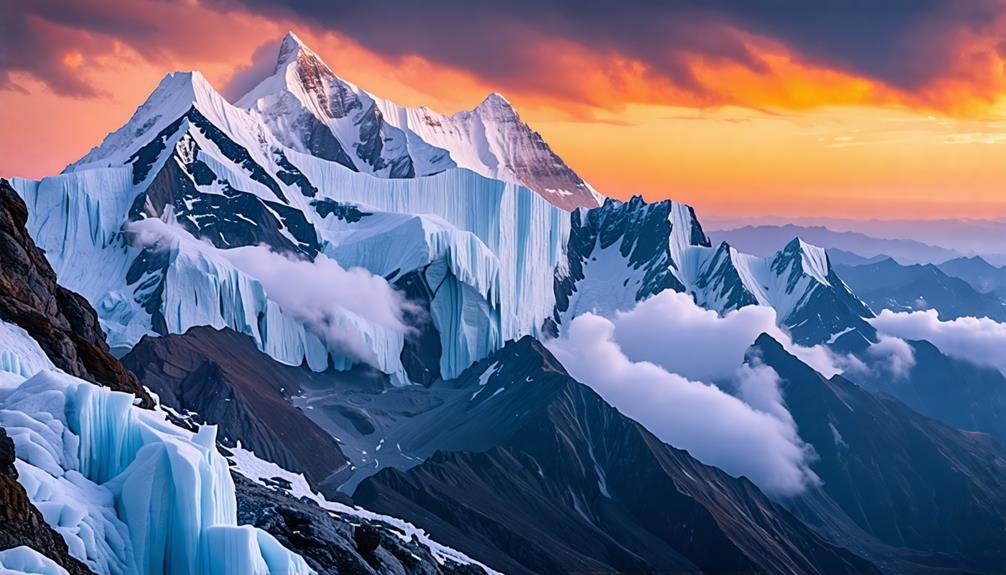
Climbing Kangchenjunga presents numerous challenges. The mountain, standing at 28,169 feet, ranks as the third-highest peak globally. Its elevation poses risks of severe altitude sickness. Climbers face unpredictable weather, which can lead to sudden storms, heavy snowfall, and icy conditions, creating hazardous environments.
The remote Himalayas complicate rescue operations, as assistance may be difficult to access. Additionally, the ascent routes are not simple; climbers encounter steep ridges and concealed crevasses that demand skillful navigation.
Despite these obstacles, adventurers are captivated by Kangchenjunga's stunning landscapes and the immense satisfaction that accompanies reaching the summit. Adequate preparation, including rigorous physical training and awareness of the mountain's dynamics, is crucial for a successful expedition. Equipped with the right gear from reputable brands, climbers can embrace the thrill while ensuring their safety. The journey up Kangchenjunga not only tests one's abilities but also pays homage to the awe-inspiring beauty of nature, inviting those with adventurous spirits to meet the challenge head-on.
The Eiger's Isolated Threats
The Eiger, a formidable mountain in the Swiss Alps, presents climbers with distinct challenges, especially its steep North Face and erratic weather patterns. This breathtaking peak requires respect and prudence from those who attempt its ascent. Recognizing the inherent dangers can aid climbers in their preparations.
Key hazards on the Eiger include:
- Steep North Face: The nearly vertical climb poses significant fall risks and necessitates expert climbing abilities.
- Rockfall Hazards: Unstable rocks can unexpectedly dislodge, threatening climbers situated below.
- Avalanche Risks: The mountainous landscape is susceptible to avalanches, particularly following substantial snowfall.
- Cold Temperatures: Low temperatures can lead to frostbite and hinder climbing performance.
Despite the Eiger's considerable challenges, climbers can reduce risks through comprehensive planning, strong teamwork, and rigorous training. By acknowledging these hazards, adventurers can approach the peak with the necessary confidence to appreciate its breathtaking beauty while remaining mindful of its dangers. Equipped with the right mindset and gear, the Eiger can shift from a daunting giant into an exhilarating expedition.
Makalu's Unpredictable Weather
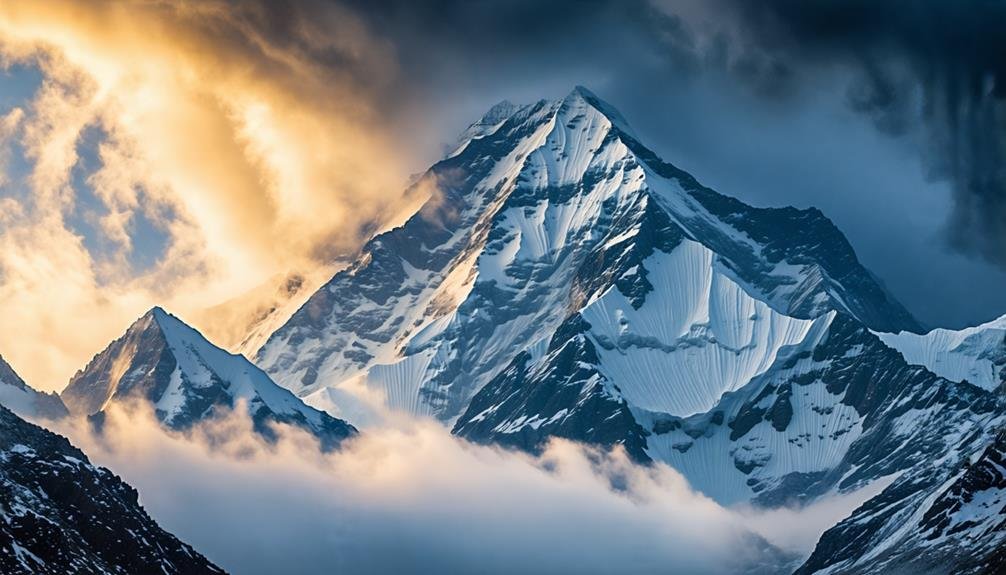
How does Makalu's unpredictable weather challenge even the most experienced mountaineers? Makalu, the fifth-tallest peak on Earth, is infamous for its swiftly changing climate. Adventurers may commence their climb under sunny skies, only to encounter violent storms and heavy snowfall within hours. These abrupt changes can result in whiteouts, where visibility plummets to nearly nothing, complicating navigation significantly.
Additionally, the mountain's altitude causes extreme temperature variations. A climber could feel warmth in the sun, then quickly be hit with freezing temperatures as clouds move in. Such unpredictability can lead to frostbite and hypothermia if climbers do not take necessary precautions.
The steep cliffs and complex landscape further exacerbate the situation. As mountaineers traverse these demanding terrains, they must remain vigilant for the unforeseen. They need to keep a close eye on weather updates, but even the most reliable forecasts can miss the mark.
Despite these difficulties, adventurers are captivated by Makalu's stunning scenery and exhilarating challenge. With thorough preparation, respect for the mountain, and a sharp awareness of shifting conditions, climbers can embrace the excitement of summiting Makalu while ensuring their safety.
Matterhorn's Historic Dangers
Experiencing the historic dangers of the Matterhorn demands a comprehensive understanding of its perilous conditions and the obstacles encountered by mountaineers over the years. Renowned for its stunning beauty, the Matterhorn also poses significant hazards that have claimed numerous lives. Climbers must navigate a challenging environment where weather can shift rapidly, leading to critical scenarios.
Here are some historic dangers linked to the Matterhorn:
- Avalanches: Snow and ice can abruptly detach, creating substantial risks.
- Rockfall: Loose boulders may descend unexpectedly, particularly during the warmer seasons.
- Altitude Sickness: Climbers must adapt to the elevated terrain to prevent severe health complications.
- Technical Climbing: The ascent demands advanced mountaineering skills, rendering it inappropriate for inexperienced climbers.
Despite these threats, the Matterhorn continues to represent adventure and challenge. With adequate preparation, climbers can mitigate dangers while savoring the mountain's breathtaking splendor. Recognizing these historic dangers is essential for safely enjoying the exhilaration of climbing one of the globe's most iconic mountains.
Denali and Its Fierce Elements
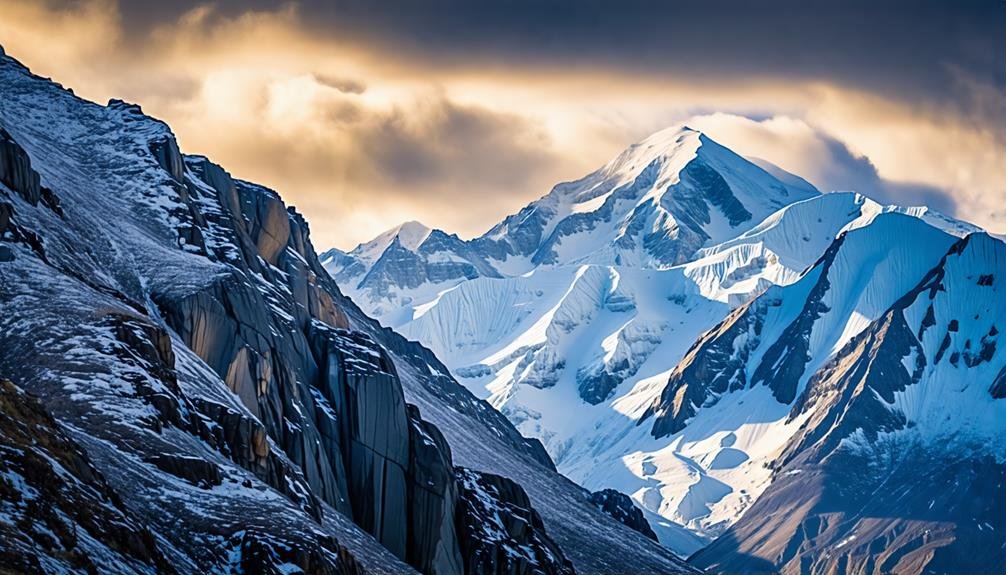
Denali, North America's highest mountain, challenges climbers with extreme temperatures, strong winds, and a low summit success rate. Rising to 20,310 feet, Denali experiences rapid weather changes, often seeing temperatures drop below -40 degrees Fahrenheit. These severe elements demand that climbers come fully prepared and equipped.
The mountain is known for its fierce winds, which can exceed 100 miles per hour, making progress slow and dangerous. As a result, the average success rate for reaching the summit is around 50%. Additionally, climbers face the risk of altitude sickness as they ascend into the thinning atmosphere, where oxygen levels diminish significantly.
Despite these challenges, Denali remains a beacon for adventurers seeking growth and exploration. Climbers often forge strong connections with their teams, relying on one another for support and motivation. The exhilaration of standing atop this breathtaking peak, overlooking a vast expanse of pristine wilderness, provides an unmatched sense of liberation. With adequate preparation, reverence for the mountain, and awareness of potential dangers, climbers can embark on a demanding yet profoundly rewarding journey.

